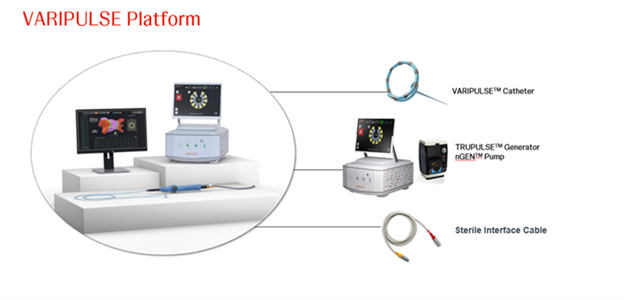VARIPULSE Platform (VARIPULSE Catheter; TRUPULSE Generator; Sterile Interface Cable; nGEN Pump) - P240006
This is a brief overview of information related to FDA’s approval to market this product. See the links below to the Summary of Safety and Effectiveness Data (SSED) and product labeling for more complete information on this product, its indications for use, and the basis for FDA’s approval.
Product Name: VARIPULSE Platform (VARIPULSE Catheter; TRUPULSE Generator; Sterile Interface Cable; nGEN Pump)
PMA Applicant:Biosense Webster, Inc.
Address: 31 Technology Drive, Suite 200; Irvine, CA 92618
Approval Date: November 6, 2024
Approval Letter: Approval Order
What is it?
The VARIPULSE Platform includes a thin, flexible wire (catheter) with a tip shaped like a loop that has ten metal electrodes, a pulsed field generator, an irrigation pump, and an interface cable. These parts, when used with other equipment that tests how well the heart’s electrical signals are working (electrophysiology), are used to treat an irregular heartbeat that has episodes lasting less than 7 days, called paroxysmal atrial fibrillation, through a procedure called catheter ablation.
A doctor puts the catheter into a vein in the groin through a small cut and moves the tip of the catheter through the blood vessels up to the heart. The doctor places the loop at different places in the heart and uses the generator to send pulsed fields. Pulsed fields are fast electrical pulses that make holes in the thin barrier surrounding each heart cell, which causes the cells to die. The dead heart cells block electrical signals that can lead to atrial fibrillation. The catheter is removed after treatment.
VARIPULSE Catheter
The VARIPULSE Catheter is indicated for use to map the electrical currents in the heart (cardiac electrophysiological mapping) using stimulation and electrogram recording. When used with a TRUPULSE Generator, the VARIPULSE System is also indicated for the treatment of drug refractory recurrent symptomatic paroxysmal atrial fibrillation, which is a rapid heartbeat that causes noticeable symptoms, does not respond to medications, happens more than once but each episode stops within 7 days. The catheter provides placement information when used with the CARTO 3 System. VARIPULSE is intended for use in adults 18 years old and above.
TRUPULSE Generator
The generator is indicated for use together with a compatible cardiac ablation catheter such as the VARIPULSE Catheter to deliver pulsed fields during ablation procedures.
Sterile Interface Cable
This cable connects an electrophysiology catheter to other electrophysiology equipment. The cable can be reused if cleaned and sterilized according to the device’s Instructions for Use.
nGEN Pump
The nGEN Pump is a tube or hose (peristaltic) pump designed to work with compatible irrigation tubing sets, either on its own or with a compatible generator, to carry the fluid that washes out areas of the body (irrigation solution) to a compatible catheter that delivers it (irrigation catheter).
In a clinical study (AdmIRE), 291 people with drug refractory, recurrent symptomatic paroxysmal atrial fibrillation were selected to participate, of whom 255 had heart ablation with the VARIPULSE Platform. The study was designed to show that treatment with the VARIPULSE Catheter System met predefined performance goals for safety and effectiveness. Of the patients treated with the VARIPULSE Platform, 183 did not experience another episode (recurrence) of their atrial fibrillation within 12 months (74.4%). This performance met the pre-defined criteria for effectiveness.
Do not use the VARIPULSE Platform in people who:
- Had heart surgery where an incision was made in the upper chambers of the heart (atriotomy) within the 8 weeks before. Recent surgery may increase the risk of tearing a hole in the heart (perforation).
- Have a tumor (myxoma) or blood clot in the heart (intracardiac thrombus). Use of the catheter may cause the myxoma or thrombus to block blood flow (emboli).
- Have an artificial (prosthetic) valve. The catheter may damage the prosthetic valve or cause the catheter to get caught (entrapment) or block blood flow.
- Have a bloodstream infection (active systemic infection). The catheter may increase the risk of the infection spreading to the heart.
- Have a history of heart attack (myocardial infarction) as these patients may be more vulnerable to irregular, fast heartbeats in the lower chambers of the heart (ventricular tachycardia).
- Are pregnant. The effects of pulsed field energy on an unborn child (fetus) are unknown.
In addition, the VARIPULSE Platform should not be used:
- With an approach that requires incisions in the heart if the patient has a baffle or patch between the two upper chambers of the heart (atria) to redirect blood flow (interatrial baffle or patch). An incision made may not close, creating a problem between the atria called an iatrogenic atrial shunt.
- With a common access route to the heart called a retrograde transaortic approach. The approach may increase the risk of a tear in the heart tissue.
- In the lower chambers of the heart (ventricles). The catheter may become entangled with the heart valves.
- In the coronary arteries. The catheter may damage these arteries or cause tissue damage from lack of blood supply (infarction).
- Through access points in arteries or the large vein in the neck (jugular). The catheter may injure the blood vessels or cause bleeding (hematoma).

